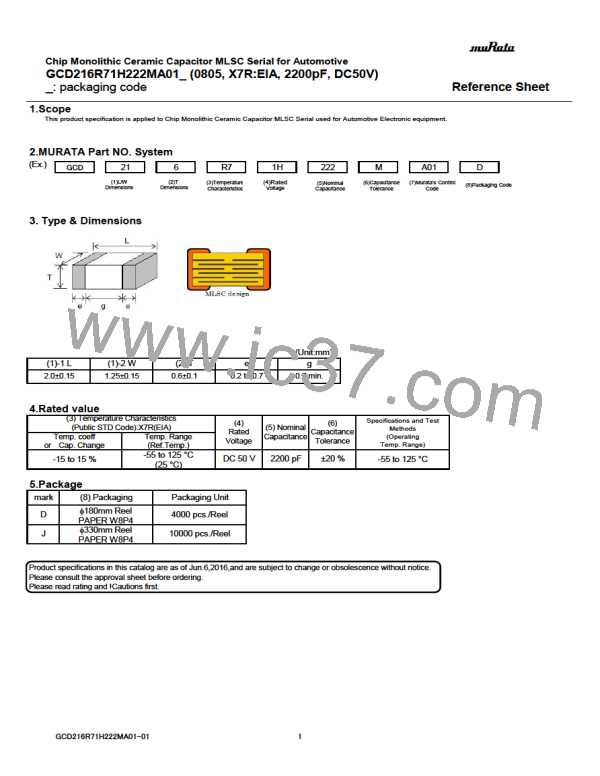■AEC-Q200 Murata Standard Specification and Test Methods
No
AEC-Q200 Test Item
Specification.
AEC-Q200 Test Method
18 Board Flex
Appearance
No marking defects
Solder the capacitor on the test board (glass epoxy board) shown in Fig1.
Then apply a force in the direction shown in Fig 2 for 60s.
The soldering should be done by the reflow method and should be
conducted with care so that the soldering is uniform and free of defects
such as heat shock.
Capacitance
Change
D.F.
R7 : Within ±10.0%
R7 : 0.025 max.
Type
GCD18
GCD21
a
b
c
0.6
0.8
2.2
3.0
0.9
1.3
I.R.
More than 10,000MΩ or 500Ω ・F
(Whichever is smaller)
b
114
f4.5
20
Pressurizing
speed:1.0mm/s
Pressurize
R4
a
100
Flexure:≦2
(High Dielectric Type)
Capacitance meter
45 45
Fig.1
t : 1.6mm
Fig.2
19 Terminal
Strength
Appearance
No marking defects
Within specified tolerance
R7 : 0.025 max.
Solder the capacitor on the test board (glass epoxy board) shown in Fig 3.
Then apply 18N force in parallel with the test jig for 60s.
Capacitance
Change
D.F.
The soldering should be done either with an iron or using the reflow
method and should be conducted with care so that the soldering is
uniform and free of defects such as heat shock
I.R.
More than 10,000MΩ or 500Ω ・F
Type
GCD18
GCD21
a
b
c
(Whichever is smaller)
1.0
1.2
3.0
4.0
1.2
1.65
(in : mm)
c
t: 1.6mm
Solder resist
Baked electrode or
Copper foil
Fig.3
20 Beam Load Test
Destruction value should be exceed following one.
< Chip L dimension : 2.5mm max. >
Place the capacitor in the beam load fixture as Fig 4.
Apply a force.
< Chip Length : 2.5mm max. >
Chip thickness > 0.5mm rank : 20N
Iron Board
Fig.4
Speed supplied the Stress Load : 0.5mm/s
JEMCGS-00806C
5

 MURATA [ muRata ]
MURATA [ muRata ]